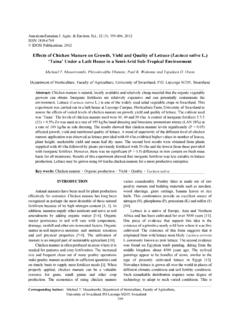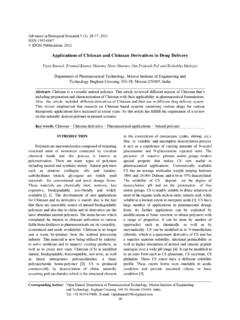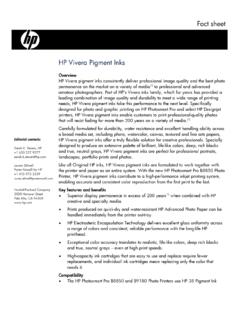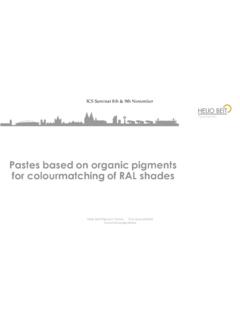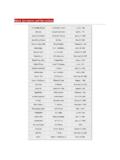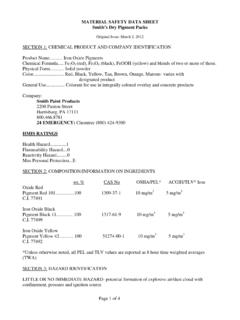Transcription of Effect of Carbon and Nitrogen Sources on Stimulation of ...
1 International Journal of Microbiological Research 2 (2): 184-187, 2011 ISSN 2079-2093 IDOSI Publications, 2011 Corresponding Subhasree, Defence Bio-Engineering and Electromeical Laboratory, DRDO, Bangalore, India. E-mail: of Carbon and Nitrogen Sources on Stimulation of Pigment Production by Monascus purpureus on Jackfruit Subhasree, P. Dinesh Babu,12R. Vidyalakshmi and V. Chandra Mohan34 Defence Bio-Engineering and Electromeical Laboratory, DRDO, Bangalore, India1 Sona School of Management, Salem, India2 Indian Institute of Crop Processing Technology, Thanjavur, India3 Department of Management, College of Enginnering, Trichirapalli, India4 Abstract:Food colorants from natural Sources are preferred over the synthetic variants which elicits variousadverse effects including teratogenicity and carcinogenicity.
2 pigments produced fromMonascus ofmicrobial origin and can be used as food grade biocolorants. The aim of the present work was to investigatethe feasibility of Jackfruit seed as a substrate supplemented with Carbon Sources like mannitol, lactose, starchand fructose and Nitrogen Sources like yeast extract, peptone, ammonium sulphate and ammonium nitrate forthe production of pigments by Monascus purpureus in solid-state fermentation (SSF). The absorbance maximaof pigment extract was measured by spectral analysis. The maximum pigment production was found whenMonascus purpureus culture is supplemented with fructose as Carbon source and yeast extract as the words: Solid state fermentation Monascus purpureus Pigment Carbon and Nitrogen sourcesINTRODUCTION monascorubrin (C H O ) and rubropunctatin (C H O );The most commonly used food grade pigments arerubropuntamine (C H NO ) [3-5].
3 The color of thechemical compounds containing nitrite and nitrate is influenced by the culture conditions, pH valueThese synthetic compounds have been reported to haveand the Carbon and Nitrogen Sources in the substrate [6,carcinogenic and teratogenic effects. This has been one7].Monascus pigments can be obtained from both solid-of the major reasons for the increased interest instate and submerged culture. In Solid state fermentationproducing pigments from biological origin like plants andprocess, the substrates not only supply the nutrients tomicroorganisms [1]. The best known of the microbialthe microbial culture growing on it, but also serve as ancolorants are produced byMonascusgroup, specificallyanchorage for the cells resulting in high pigmentM.
4 Ruber, M. ankaandM. purpureus, because of theirproductivity. Moreover, it is a low-cost process usingchemical stability. During growth, Monascusspp. breaksagro-industrial residues as substrates [8, 9]. Cheapdown starch substrate into several metabolites, of whichagricultural products and residues were used aspigments are produced as secondary metabolites. Thesubstrates for pigment production such as rice broken,structure of pigments depends on type of substrate andwheat bran, jackfruit seeds, palm kernel cake, cassavaother specific factors during culture such as pH,starch etc. [10-13]. Since the jackfruit seeds are rich intemperature and moisture content [2].carbohydrate, protein and trace elements, it can be usedMonascus fungi produce at least six majoras a potential substrate for the production of food graderelated pigments which can be categorized into 3 groupspigments.
5 In the present study, the effects of Carbon andbased on color as follows: yellow pigments : monascinnitrogen Sources on red and yellow pigment production(C H O ) and ankaflavin (C H O ); orange pigments :were red pigments : monascorubramine (C H NO ) and2327421234 Intl. J. Microbiol. Res., 2 (2): 184-187, 2011185 MATERIALS AND METHODS pigment extract was measured by spectral analysis at 510 Materials: Jackfruit seeds were procured from the localrespectively using a double beam spectrophotometermarket in Thanjavur and air purpureus(Shimadzu UV 1601). Pigment yield was expressed as ODwas cultured at Indian Institute of Crop Processing andat its per gram dry fermented matter [16].Technology and used for pigment was maintained in potato dextrose agar slantRESULTSand sub cultured in yeast phosphate soluble starchmedium (yeast g, soluble g,Growth of M.)
6 Purpureus in Solid State Fermentation:K HPO g, KH PO g, g, distilled water-24241000 ml, pH ).Production of pigments by Solid State Fermentation:Jackfruit seeds were grated and about 20 g in weight wasused as substrate. Different Carbon Sources like mannitol,lactose, starch and fructose at the concentration of 3%w/w of the substrate were used. The jackfruit seedsubstrate was supplemented with Nitrogen source likeyeast extract, peptone, ammonium sulphate or ammoniumnitrate at a concentration of w/w of substrate. Thismedium was then moistened to 60% as analysed bymoisture analyser [14]. The samples were labelled as C1-Jackfruit seed + mannitol, C2-Jackfruit seed + fructose, C3-Jackfruit seed + lactose, C4-Jackfruit seed + starch,control-Jackfruit seed alone, N1-Jackfruit seed + yeastextract, N2-Jackfruit seed + peptone, N3-Jackfruit seed +ammonium sulphate, N4-Jackfruit seed+ ammonium nitrateand autoclaved.
7 All the samples were inoculated with 1 mlof 14-days-old culture ofM. purpureus and incubated at30 C for 7-14 days. After incubation, the flasks weresterilized and Monascus fermented products were dried at50 C for 24 hours. Dried Monascus Fermented Product(MFP) was pulverized in a Udy cyclone mill and used forfurther and Estimation of pigments : The soluble extra-cellular pigments were extracted with ethanol by adding50 mL of 70% Ethanol to g of MFP and incubated inwater bath at 60 C for 2 hours and ?ltered throughWhatmann ?lter paper. Pigment estimation was doneas described by Tsenget al. [15] in which the opticaldensity of the ethanol extract was expressed as a functionof the pigment concentration. The absorbance maxima ofand 410 nm as an estimate of red and yellow pigments ,maxThe growth of the fungus was monitored at intervalsof 2, 7 and 14 days of incubation.
8 Fungal myceliacould be observed from second day in the samplessupplemented whereas unsupplemented samples (control)show growth only after five days. After 14 days ofincubation, dense growth and pigment production werenoted in Nitrogen and Carbon supplemented sampleswhen compared with the control. The results weretabulated in Table of Carbon Source on Pigment Production:The Effect of various Carbon Sources supplemented tojackfruit seed substrate on the red pigment productionwas studied by measuring the absorbance at 510 and 410nm as an estimate of red and yellow pigments ,respectively and the results are given in figure 1. Fructoseas the Carbon source was found to give the maximum yieldof U/g and U/g for red and yellow pigmentsrespectively.
9 Next to fructose, starch yielded U/gand Lactose supplemented sample U/g and U/g and mannitol with the leastpigment yield of U/g and U/g when comparedwith other Carbon cupplemented samples. Fructosesupplementation resulted in about increase in of Nitrogen Source on Pigment Production:From the spectral analysis observed for changes indifferent Nitrogen Sources , yeast extract was found toyield maximum pigment of U/g and U/g followedby peptone U/g and U/g, ammonium U/g and U/g and ammonium nitrate U/gand U/g. As compared to the control, addition ofnitrogen Sources increased the yield of pigment upto (Fig. 2).Table 1: Growth of M. purpureus in the control and supplemented samples IncubationControlJackfruit seed Jackfruit seed Jackfruit seed Jackfruit seedJackfruit seedJackfruitJackfruit seedJackfruit seedPeriodJackfruit seed + Mannitol + Fructose + Starch + Lactose + Yeast extract seed + Peptone + Ammonium nitrate + Ammonium sulphate2 days -++++++--7 days +++++++++++++++14 days +++++++++++++++++++++-No Growth; + Moderate Growth; ++ Dense Growth; +++ Dark pigmentation with dense growthIntl.
10 J. Microbiol. Res., 2 (2): 184-187, 2011186 Fig. 1: Effect of Carbon source supplementation on pigment yieldFig. 2: Effect of Nitrogen source supplementation on pigment yieldDISCUSSIONREFERENCESThe interest in red pigments produced , P., L. Martinkova and D. Vesely, use in the food industry has been mounting givenBiological activity of polyketide pigmentsthe flexibility in production and easy down streamingproduced by the fungus Monascus. J. reported to produce non-toxicMicrobiol., 79: , which can be used as food colorant. Besides Pattanagul, Renu Pinthong Aphirakadding color, it enhances the flavor of the food and actsPhianmongkhol and Noppol Leksawasdi, food preservative. The use of jackfruit seeds forReview of Angkak Production (Monascussubstrate is cost-effective as well as environment ).
